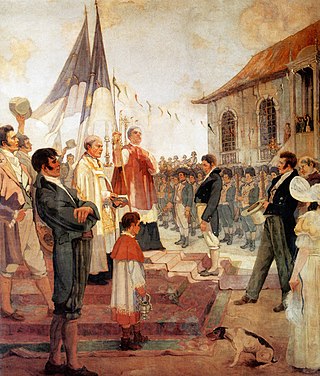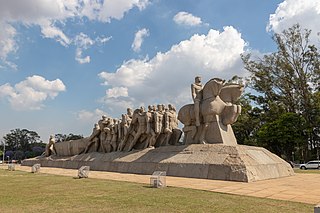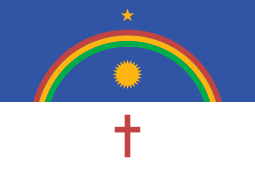
Paraíba is a state of Brazil. It is located in the Brazilian Northeast, and it is bordered by Rio Grande do Norte to the north, Ceará to the west, Pernambuco to the south and the Atlantic Ocean to the east. Paraíba is the third most densely populated state of the Northeast; João Pessoa, the sea-bordered state capital, and Campina Grande, in the interior, rank among the fifteen-largest municipalities in the Northeast of Brazil. The state is home to 1.9% of the Brazilian population and produces 0.9% of the Brazilian GDP.

The national flag of Brazil, is a blue disc depicting a starry sky spanned by a curved band inscribed with the national motto "Ordem e Progresso", within a yellow rhombus, on a green field. It was officially adopted on 19 November 1889 — four days after the Proclamation of the Republic, to replace the flag of the Empire of Brazil. The concept was the work of Raimundo Teixeira Mendes, with the collaboration of Miguel Lemos, Manuel Pereira Reis and Décio Villares.

Manuel Carneiro de Sousa Bandeira Filho was a Brazilian poet, literary critic, and translator, who wrote over 20 books of poetry and prose.

The Confederation of the Equator was a short-lived rebellion that occurred in the northeastern region of the Empire of Brazil in 1824, in the early years of the country's independence from Portugal. The secessionist movement was led by liberals who opposed the authoritarian and centralist policies of the nation's first leader, Emperor Pedro I. The fight occurred in the provinces of Pernambuco, Ceará and Paraíba.

The Flag of New Holland, also known as the flag of Dutch Brazil, was the flag used by the Dutch West India Company for the territories that were under its control in Brazil from 1630 until 1654. In this period, Brazil was not granted its own flag, and only the flags of its colonizers or rulers were used.

Recife Metropolitan Area, officially the Metropolitan Region of Recife, is a major metropolitan area in Northeast Brazil with a population of 4.02 million as of 2020, centered on the state capital of Recife, Pernambuco. In 2017, it was ranked as the 8th largest Metropolitan Region nationally.

The Pernambucan revolt of 1817, also known as The Priest's Revolution, occurred in the province of Pernambuco in the Northeastern region of Brazil, and was sparked mainly by the decline of sugar production rates and the influence of the Freemasonry in the region. Other important reasons for the revolt include: the ongoing struggle for the independence of Spanish colonies all over in South America; the independence of the United States; the generally liberal ideas that came through all of Brazil the century before, including many French Philosophers, such as Charles Montesquieu and Jean-Jacques Rousseau; the actions of secret societies, which insisted on the liberation of the colony; the development of a distinct culture in Pernambuco.

Events in the year 1911 in Brazil.

Events in the year 1927 in Brazil.

Events in the year 1999 in Brazil.

Monument to the Bandeiras is a large-scale granite sculpture by the Italian-Brazilian sculptor Victor Brecheret (1894-1955) at the entrance of Ibirapuera Park in São Paulo, Brazil. It was commissioned by the government of São Paulo in 1921 and completed in 1954. It commemorates the 17th-century bandeiras, or settling expeditions into the interior of Brazil, and the bandeirantes that participated in them. The monument is huge and in a prominent location, making it an easily identifiable part of the landscape of São Paulo.

The flag of the state of São Paulo, Brazil, serves as one of the state's symbols, along with the state's coat of arms and anthem. It was designed by the philologist and writer Júlio Ribeiro in 1888, with his brother-in-law, Amador Amaral, a graphic artist. The flag has thirteen black and white stripes and a red rectangle in the upper left corner holding a white circle enclosing an outline map of Brazil in blue. There is a yellow star in each corner of the red rectangle.

The Constituent Cortes of 1820, formal title The General and Extraordinary Cortes of the Portuguese Nation, also frequently known as the Sovereign Congress or the Cortes Constituintes Vintistas, was the first modern Portuguese parliament. Created after the Liberal Revolution of 1820 to prepare a constitution for Portugal and its overseas territories, it used a different system from the traditional General Cortes for choosing representatives, and the three traditional feudal estates no longer sat separately. The Cortes sat between January 24, 1821 and November 4, 1822 at the Palácio das Necessidades in Lisbon. The work of the Constitutional Cortes culminated in the approval of the Portuguese Constitution of 1822.

The flag of Roraima is one of the official symbols of the state of Roraima in Brazil.
The politics of Pernambuco is the direction of Pernambuco's territory and the determination of the powers that make up its government structure. It is governed by three branches, the executive, the legislative, and the judiciary, and its current constitution was enacted on October 5, 1989; the first constitution was enacted in 1891 and after that there were three others.

The flag of Mato Grosso is the official flag of the Brazilian state of Mato Grosso. The current flag was introduced on 31 January 1890 by the 2nd Decree of the state of Mato Grosso. It was introduced only 2 months after the Empire of Brazil was overthrown and the First Brazilian Republic was created, making this one of the first Brazilian state flags. As such, it uses the same colors and symbolism used in the Brazilian flag to signify the republican ideals of the founders of the newly formed nation.

The state flag of Mato Grosso do Sul was designed by a group of University of São Paulo students and adopted on 1 January 1979 by the 1st decree of the state of Mato Grosso do Sul.





















